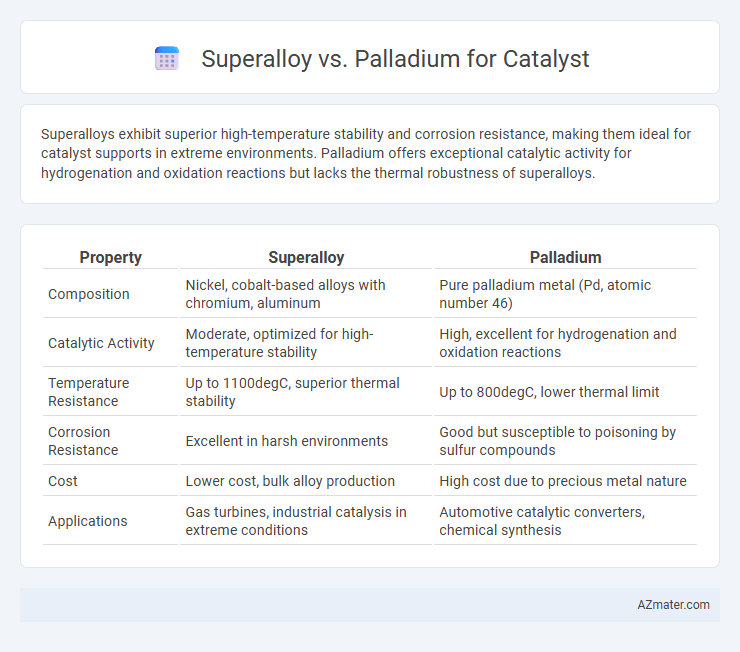Superalloys exhibit superior high-temperature stability and corrosion resistance, making them ideal for catalyst supports in extreme environments. Palladium offers exceptional catalytic activity for hydrogenation and oxidation reactions but lacks the thermal robustness of superalloys.
Table of Comparison
| Property | Superalloy | Palladium |
|---|---|---|
| Composition | Nickel, cobalt-based alloys with chromium, aluminum | Pure palladium metal (Pd, atomic number 46) |
| Catalytic Activity | Moderate, optimized for high-temperature stability | High, excellent for hydrogenation and oxidation reactions |
| Temperature Resistance | Up to 1100degC, superior thermal stability | Up to 800degC, lower thermal limit |
| Corrosion Resistance | Excellent in harsh environments | Good but susceptible to poisoning by sulfur compounds |
| Cost | Lower cost, bulk alloy production | High cost due to precious metal nature |
| Applications | Gas turbines, industrial catalysis in extreme conditions | Automotive catalytic converters, chemical synthesis |
Introduction to Catalyst Materials: Superalloy vs Palladium
Superalloy and palladium are critical catalyst materials distinguished by their unique chemical properties and durability in high-temperature reactions. Palladium is renowned for its excellent catalytic activity and selectivity in hydrogenation and automotive catalytic converters, leveraging its noble metal characteristics. Superalloys, composed primarily of nickel, cobalt, and chromium, offer exceptional thermal stability and resistance to oxidation, making them suitable for harsh catalytic environments such as industrial chemical reactors.
Chemical Properties Relevant to Catalysis
Superalloys exhibit high thermal stability and oxidation resistance, making them suitable for catalysis in extreme temperature environments, though their catalytic activity is generally lower than palladium. Palladium demonstrates excellent catalytic properties due to its ability to adsorb and activate hydrogen, enabling efficient hydrogenation and dehydrogenation reactions. The distinct electronic structure of palladium facilitates versatile catalytic cycles, while superalloys primarily contribute mechanical durability rather than inherent catalytic reactivity.
Structural Differences: Superalloy and Palladium Explained
Superalloys are complex metal matrices primarily composed of nickel, cobalt, or iron, designed for exceptional strength and corrosion resistance at high temperatures, while palladium is a pure precious metal known for its excellent catalytic properties and stability. Structurally, superalloys display a polycrystalline microstructure with gamma prime (g') precipitates that reinforce mechanical strength, whereas palladium has a face-centered cubic (FCC) crystal lattice enabling effective adsorption and activation of reactant molecules. These fundamental structural differences dictate their applications in catalysis, with superalloys favored in high-temperature environments and palladium preferred for catalytic converters and chemical reactions requiring precise surface interactions.
Activity and Efficiency in Catalytic Reactions
Superalloys exhibit exceptional thermal stability and mechanical strength, making them highly efficient catalysts in high-temperature catalytic reactions by maintaining active surface sites under extreme conditions. Palladium's superior catalytic activity, particularly in hydrogenation and carbon-carbon coupling reactions, arises from its ability to facilitate electron transfer and adsorb reactants at lower temperatures. Comparing both, superalloys offer durability and sustained efficiency in harsh environments, while palladium provides higher intrinsic activity and selectivity in specific catalytic processes.
Resistance to Deactivation and Poisoning
Superalloys exhibit exceptional resistance to deactivation and poisoning due to their robust high-temperature stability and corrosion resistance, making them ideal for catalytic environments with harsh chemical exposures. Palladium catalysts, while highly active and selective, are more susceptible to poisoning by sulfur, carbon monoxide, and other contaminants that can block active sites and decrease efficiency. The choice between superalloys and palladium depends on operating conditions, with superalloys favored for long-term durability under aggressive conditions and palladium preferred for applications requiring high catalytic specificity but cleaner feedstocks.
Cost Analysis: Superalloy vs Palladium in Industrial Use
Superalloys typically offer a cost-effective alternative to palladium in industrial catalytic applications due to their lower raw material expenses and longer lifespan under high-temperature conditions. Palladium, while highly efficient as a catalyst, incurs higher costs because of its scarcity and market volatility, impacting overall process economics. Evaluating cost per unit of catalytic activity reveals superalloys can reduce operational costs significantly in large-scale chemical manufacturing.
Environmental Impact and Sustainability
Superalloys, primarily composed of nickel, cobalt, and chromium, provide high durability and corrosion resistance but often require energy-intensive extraction and processing, resulting in a significant environmental footprint. Palladium, a precious metal widely used in catalytic converters, offers excellent catalytic efficiency with lower energy demand during operation; however, its limited natural availability and mining practices raise concerns about resource depletion and environmental degradation. Sustainability in catalyst selection increasingly favors materials with lower extraction impact and higher recyclability, positioning emerging superalloy catalysts as promising alternatives to palladium for long-term environmental benefits.
Application Areas: Superalloy and Palladium Catalysts
Superalloys are extensively used in high-temperature industrial applications such as aerospace engines and gas turbines, where their exceptional thermal stability and resistance to oxidation enhance catalyst durability. Palladium catalysts excel in automotive catalytic converters and chemical reactions like hydrogenation and carbon-carbon coupling due to their superior catalytic activity and selectivity. These distinct application areas highlight superalloys' role in structural and thermal catalyst support, while palladium is preferred for reactive and environmental catalysis.
Recent Advances in Catalyst Engineering
Recent advances in catalyst engineering highlight the superior thermal stability and oxidation resistance of superalloys, enhancing catalyst lifespan and efficiency in high-temperature environments. Palladium catalysts exhibit exceptional selectivity and activity in hydrogenation and automotive emission control but face challenges due to cost and susceptibility to poisoning. Innovations in nanostructuring and alloying have improved the durability and performance of both superalloys and palladium-based catalysts, driving progress in sustainable industrial applications.
Future Prospects and Selection Criteria
Superalloys offer exceptional thermal stability and mechanical strength for catalysts used in high-temperature industrial processes, while palladium excels in catalytic activity, particularly for automotive emissions control and hydrogen purification. Future prospects favor superalloys in applications requiring durability under extreme conditions, whereas palladium remains crucial for emerging clean energy technologies and fuel cells due to its superior catalytic efficiency and resistance to poisoning. Selection criteria depend on operating temperature, chemical environment, mechanical stress tolerance, and cost-effectiveness, with palladium preferred for lower-temperature catalytic reactions and superalloys for long-term stability in harsh environments.

Infographic: Superalloy vs Palladium for Catalyst
 azmater.com
azmater.com